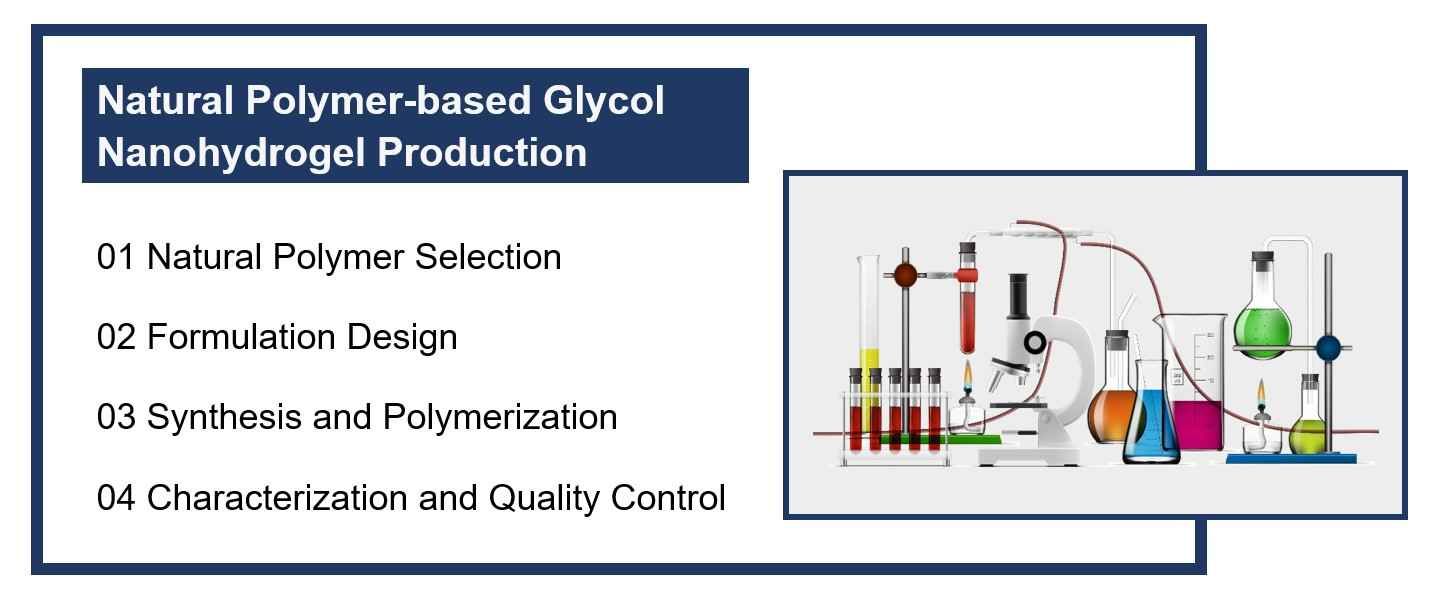


Natural polymers are obtained from nature and have the advantages of good biocompatibility, degradability, and environmental friendliness. They are ideal skeletons for making hydrogels. Hydrogels developed based on natural polymers have received extensive attention in biomedical fields such as drug delivery, wound healing, and regenerative medicine. At CD BioGlyco, we use advanced technology to provide high-quality, customized nanohydrogel production services to scientific researchers and enterprises to meet the unique needs of our clients.
 Fig.1 Overview of natural polymer-based hydrogels. (Zhao, et al., 2023)
Fig.1 Overview of natural polymer-based hydrogels. (Zhao, et al., 2023)
Our GlycoNano™ Platform integrates advanced synthesis technology, precise characterization methods, and perfect activity analysis methods to provide clients with one-stop services from raw material selection to product delivery. Nanohydrogels occupy an important position in the biomedical field. We provide clients with Natural Polymer-based Nanohydrogel Production Services and Synthetic Polymer-based Nanohydrogel Production Services. Commonly used technologies include but are not limited to:
Natural polymer-based nanohydrogels derived from natural materials have attracted wide attention due to their applications in pharmaceuticals, agriculture, medicine, tissue engineering, cancer treatment, and drug delivery. Natural polymers used for hydrogel manufacturing include gelatin, cellulose, chitosan, dextran, alginate, hyaluronic acid, and its derivatives. These polymers are used to construct engineered nanohydrogels through strategies such as ionic interactions, physical crosslinking, and chemical crosslinking. Here, we provide clients with a variety of production services for polymer nano hydrogels based on natural sources. Our services are as follows:
We exploit the unique properties of carbohydrates to develop and produce a wide range of nanohydrogel materials for applications such as drug delivery, tissue engineering, and wound healing. Our cutting-edge technologies and characterization methods ensure precise control of the size, structure, and functionality of nanohydrogels to meet specific clients' needs and industry standards.
Glycosaminoglycans provide nanohydrogels with enhanced properties such as improved moisture retention, bioactivity, and mechanical stability. These properties make our glycosaminoglycan-based nanohydrogels potentially advantageous in skin care, regenerative medicine, and pharmaceutical applications.
Peptides and glycoproteins have inherent bioactivity, specificity, and biocompatibility. Our peptide- and glycoprotein-based nanohydrogels are carefully designed to promote targeted drug delivery, cell adhesion, and controlled release, among others.
Engage with the clients to understand the specific requirements, including the intended application of the nanohydrogel, parameter requirements, etc. to define the scope, composition, and properties required for the final product. Select the appropriate natural polymer, which may include alginate, chitosan, protein, or other biocompatible materials.
Designing the precise formulation of the nanohydrogel involves determining the ratio of each component and the conditions required for synthesis to ensure that the hydrogel meets the necessary mechanical and biological properties.
Depending on the characteristics of the polymer, strategies such as emulsion polymerization, nanoprecipitation, self-assembly, physical cross-linking, or chemical cross-linking are used to synthesize the nanohydrogel. After synthesis, the nanohydrogel is purified to remove any unreacted materials or by-products.
The nanohydrogel is rigorously tested to evaluate its structure, size, morphology, mechanical properties, and functionality to ensure that the product meets all specified standards.

DOI: 10.1038/s41598-020-80133-3
Journal: Scientific Reports
Published: 2021
IF: 3.8
Results: A novel nanobiocomposite scaffold CTT-CS/SF/Mg(OH)2 was synthesized by modifying cross-linked terephthaloyl thiourea-chitosan (CTT-CS) hydrogel with silk fibroin (SF) and Mg(OH)2. Then its cytotoxicity, antimicrobial activity, and biocompatibility were evaluated. The formation and presence of new chemical bonds and functional groups were determined by Fourier transform infrared (FTIR). Structural elements were identified by energy-dispersive X-ray spectroscopy (EDX). Different structural morphologies in each synthesis step were revealed by the field-emission scanning microscope (FE-SEM), and the thermogravimetric behavior of the nanobiocomposite scaffold was studied by thermogravimetric analysis.
 Fig.2 Synthesis preparation of CTT-CS/SF/Mg(OH)2 nanobiocomposite scafold. (Eivazzadeh-Keihan, et al., 2021)
Fig.2 Synthesis preparation of CTT-CS/SF/Mg(OH)2 nanobiocomposite scafold. (Eivazzadeh-Keihan, et al., 2021)
CD BioGlyco integrates advanced synthesis technology, sophisticated characterization methods, and comprehensive performance testing to provide clients with highly customized nanohydrogel production services. Please feel free to contact us to discuss detailed experimental plans.
References
